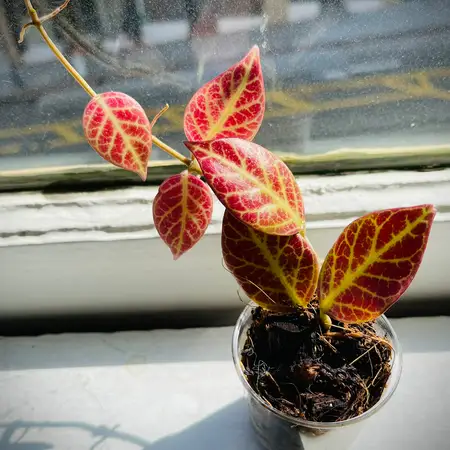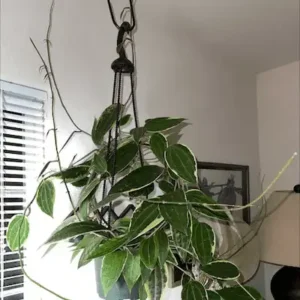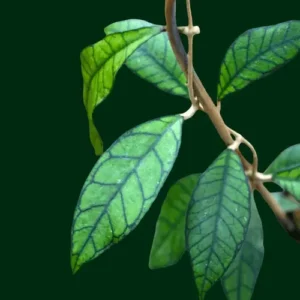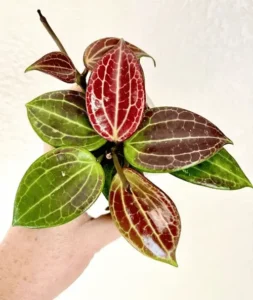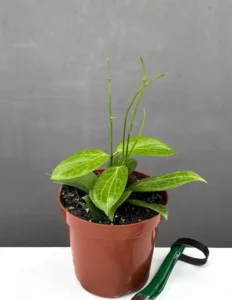Introduction
The world of houseplants is rich and diverse, with countless species that thrive both indoors and outdoors. Among them, the Hoya Sunrise plant stands out not only for its aesthetic appeal but also for its relative ease of care. Whether you’re a seasoned plant enthusiast or a budding hobbyist, the Hoya Sunrise plant is worth adding to your collection.
This article will explore everything you need to know about the Hoya Sunrise plant, including its origins, unique characteristics, care requirements, propagation, and common issues you might face while growing it. By the end, you’ll deeply understand this stunning plant and how to nurture it into a beautiful and healthy specimen.
Overview of Hoya Sunrise
Scientific Classification
- Scientific Name: Hoya ‘Sunrise’
- Family: Apocynaceae
- Genus: Hoya
- Common Name: Hoya Sunrise
Hoya Sunrise is a hybrid, specifically a cross between Hoya lacunosa and Hoya obscura. This hybrid is prized for its vibrant colors and stunning foliage, making it a favorite among plant enthusiasts. Its scientific classification places it within the Apocynaceae family, alongside other popular houseplants like Hoyas, Mandevilla, and Oleander.
Origins and History
Hoyas, often called “wax plants” due to their leaves’ glossy, waxy texture, hail from tropical and subtropical regions across Asia, Australia, and the Pacific islands. Hoya Sunrise, being a hybrid, is a relatively recent addition to the genus, likely created to combine the best traits of its parent species—Hoya lacunosa’s petite foliage and Hoya obscura’s vibrant sun-stressed coloration.
Notable Characteristics
One of the defining features of the Hoya Sunrise is its foliage. Under the right conditions, the leaves exhibit a stunning color gradient that transitions from deep green to vibrant orange or red, especially when exposed to bright light. This is where the plant gets its “sunrise” name, as the leaves resemble the colors of a sunrise.
- Leaves
Small, oval, and slightly thick, the leaves have a glossy texture that enhances their appearance. The leaf surfaces are speckled with tiny silver or white flecks, adding another layer of visual interest.
- Flowers
Like other Hoyas, the Sunrise blooms clusters of star-shaped flowers. These blooms are typically small, fragrant, and waxy in appearance. They grow in umbels, creating a beautiful floral display when the plant is mature.
Caring for Hoya Sunrise
Caring for the Hoya Sunrise is relatively straightforward, making it an ideal plant for both beginners and experienced growers. However, as with any plant, providing the right environment and care can significantly impact its health and growth.
Light Requirements
Hoya Sunrise thrives in bright, indirect light. However, one of the unique characteristics of this plant is its ability to develop vibrant, sun-stressed colors when exposed to direct sunlight for short periods. If you want to achieve the full gradient of colors in its leaves, consider giving it a few hours of morning sun or filtered afternoon sunlight.
- Best Light Conditions
Bright, indirect light, with some exposure to direct sunlight (preferably morning sun).
- Signs of Poor Lighting
If your Hoya Sunrise is placed in low light, you may notice the leaves becoming dull or losing their vibrant colors. Conversely, too much direct sun can scorch the leaves, so be mindful of finding the right balance.
Watering
Like many Hoyas, the Hoya Sunrise is relatively drought-tolerant. It prefers to dry out slightly between waterings. Overwatering can lead to root rot, so it’s crucial to ensure that the plant is not sitting in waterlogged soil.
- Watering Frequency
Water the plant thoroughly once the top 1-2 inches of soil are dry. During the growing season (spring and summer), you may need to water more frequently, while in winter, watering should be reduced.
- Watering Tips
Always use a well-draining potting mix and ensure that your pot has proper drainage holes to prevent water from accumulating at the bottom.
Humidity and Temperature
Hoya Sunrise, being a tropical plant, appreciates higher humidity levels. Ideally, aim for humidity levels of around 60% or higher, but the plant can adapt to standard indoor conditions as long as the air isn’t too dry. During the winter months, when indoor heating can dry out the air, consider using a humidifier or placing the plant on a humidity tray.
- Optimal Temperature
Keep your Hoya Sunrise in a warm environment, ideally between 65°F and 80°F (18°C to 27°C). Avoid exposing the plant to cold drafts or temperatures below 50°F (10°C), as this can stress the plant.
Soil and Potting
A well-draining, airy potting mix is essential for the Hoya Sunrise. Hoyas, in general, do not like heavy soils that retain too much moisture. You can create a suitable mix by combining standard potting soil with orchid bark, perlite, and a bit of coco coir.
- Ideal Soil Mix
1 part potting soil, 1 part orchid bark, 1 part perlite, and a small amount of coco coir or peat moss for moisture retention.
Repotting is generally not needed very often, as Hoyas prefer to be slightly root-bound. You may only need to report every 2-3 years or when you notice the roots circling the pot.
Fertilization
Hoya Sunrise can benefit from regular feeding during the growing season (spring and summer). Use a balanced, water-soluble fertilizer diluted to half-strength every 4-6 weeks. During the winter months, when the plant’s growth slows down, you can reduce or halt fertilization altogether.
Pruning and Maintenance
Pruning your Hoya Sunrise is generally not necessary, but you may want to trim back any leggy or unruly growth to keep the plant looking tidy. If the plant becomes too dense, light pruning can help increase airflow and reduce the risk of pests or disease.
Flowering
One of the greatest rewards of caring for a Hoya Sunrise is watching it bloom. However, be patient, as it may take several years for a young plant to produce flowers. To encourage blooming, provide ample bright light and ensure the plant is receiving the necessary nutrients.
The fragrant, star-shaped flowers of Hoya Sunrise grow in clusters, and the blooms can last for several weeks. Avoid removing the peduncles (flower stalks) after the flowers die off, as new blooms will often emerge from these same points.
Propagation
Propagating Hoya Sunrise is relatively easy and can be done through stem cuttings. Here’s a step-by-step guide:
- Take a Cutting
Choose a healthy, mature stem with at least two nodes (the points where leaves grow). Cut just below a node, making sure the cutting is around 4-6 inches long.
- Prepare the Cutting
Remove the leaves from the lower node, leaving a few leaves at the top.
- Rooting Medium
You can root the cutting in water or a well-draining potting mix. If rooting in water, make sure to change the water every few days to prevent rot. If rooting in the soil, keep the soil lightly moist but not waterlogged.
- Place in Indirect Light
Put the cutting in a warm area with bright, indirect light. In a few weeks, roots should begin to form.
- Transplant
Once the cutting has developed a healthy root system, you can transplant it into a pot with well-draining soil.
Common Problems and Solutions
Although Hoya Sunrise is generally low-maintenance, there are a few issues you might encounter.
1. Pests
- Common Pests
Spider mites, mealybugs, and aphids can sometimes affect Hoya Sunrise.
- Solution
Regularly check your Hoya (plant) for pests, especially on the undersides of the leaves. Treat infestations with insecticidal soap or Neem oil.
2. Root Rot
- Cause
Overwatering or poor drainage.
- Solution
To prevent root rot, always let the soil dry out between waterings and use a well-draining potting mix. If root rot occurs, prune away the affected roots and repot the plant in fresh soil.
3. Yellowing Leaves
- Cause
Overwatering, underwatering, or nutrient deficiencies.
- Solution
Adjust your watering habits and check for signs of nutrient deficiency. If needed, apply a balanced fertilizer.
4. Lack of Flowering
- Cause
Insufficient light or improper care.
- Solution
Ensure the plant is receiving bright, indirect light, and consider increasing its exposure to direct sunlight.
FAQs How do you care for a Hoya sunrise? Prolonged cold conditions are fatal to Hoya sunrises. Don’t put it next to a drafty door or window. It enjoys humidity, up to 50% to 60% since it is native to tropical climates. Since the inside of most homes is dry, installing a humidifier or keeping a saucer of water close by can be beneficial. Why is my Hoya sunrise green? If you don’t have enough nitrogen in your Hoya ‘Sunrise’ diet, you should expect dull, yellow leaves. Stunted growth and leaves that are pale green or yellow are indicators of a nitrogen shortage. How to make Hoya Sunrise red? Provide your Hoya Sunrise with bright, indirect light or diffused sunlight to help it thrive. The crimson hue on the leaves will grow more noticeable the more sunlight it receives. |
Conclusion
The Hoya Sunrise is a captivating plant with its vibrant foliage and fragrant flowers, making it a wonderful addition to any indoor garden. By following the care guidelines outlined in this article, you can cultivate a healthy and thriving Hoya Sunrise that will bring beauty and joy to your space for years to come.
Whether you’re drawn to the plant’s stunning colors or its easygoing nature, the Hoya Sunrise is a perfect companion for plant lovers of all levels.

